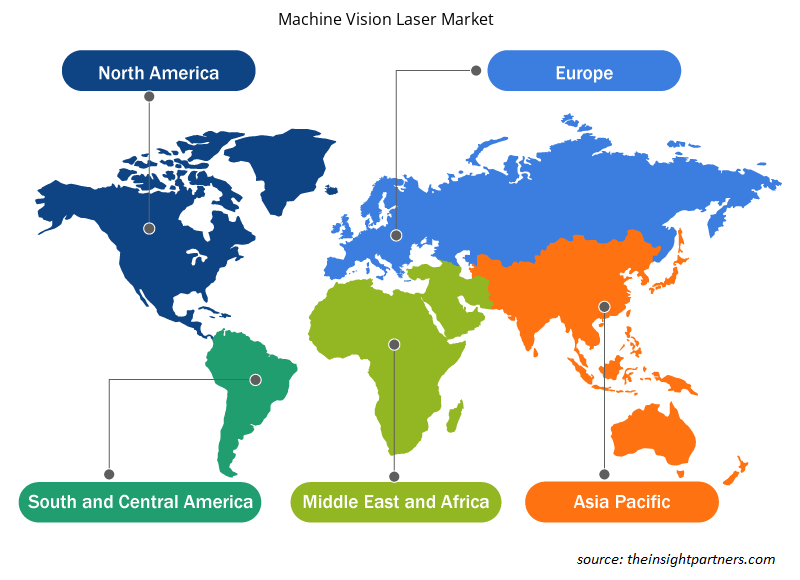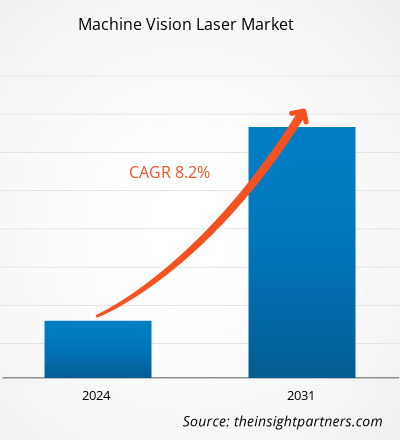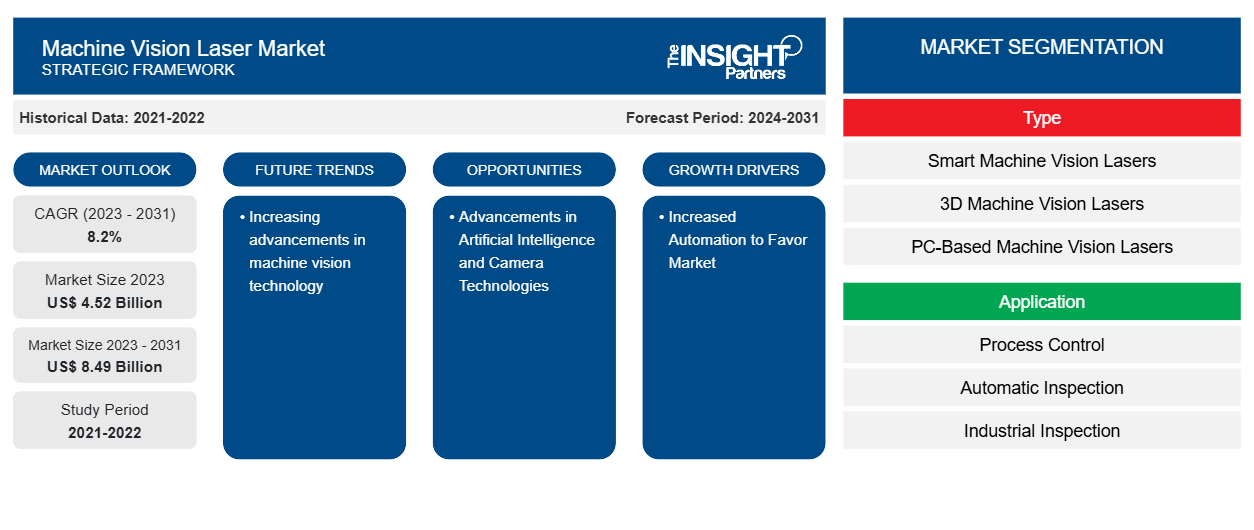世界のマシンビジョンレーザー市場規模は、2023年の45億2,000万米ドルから2031年には84億9,000万米ドルに成長すると予想されており、 2024年から2031年にかけて8.2%のCAGRで拡大すると予想されています。マシンビジョン技術の進歩は今後もマシンビジョンレーザー市場の重要なトレンドであり続けると思われます。
マシンビジョンレーザー市場分析
さまざまな業界分野における品質検査と自動化の強化に対するニーズの高まりが、市場の成長を促進すると予想されます。
マシンビジョンレーザー市場の概要
マシン ビジョン ( MV ) レーザー システムは、ビデオ カメラ、デジタル信号処理、およびアナログからデジタルへの変換を使用して、コンピューターがジョブのパフォーマンスを表示、検査、および評価できるようにします。これらのシステムはデータを収集し、その後、コンピューターに送信して処理し、必要な出力を生成します。解像度と感度は、MVシステムの 2 つの重要なパラメーターです。解像度は、システムが物体を区別する能力を決定します。同時に、感度は、低照度環境または人間の目には見えない波長で物体または弱い信号を識別する機械の能力を指します。これらのシステムは、プロセス制御、ロボット ガイド、産業用アプリケーションの自動検査などの機能を含む作業環境の管理に不可欠です。
要件に合わせてレポートをカスタマイズする
このレポートの一部、国レベルの分析、Excelデータパックなど、あらゆるレポートを無料でカスタマイズできます。また、スタートアップや大学向けのお得なオファーや割引もご利用いただけます。
-
このレポートの主要な市場動向を入手してください。この無料サンプルには、市場動向から見積もりや予測に至るまでのデータ分析が含まれます。
マシンビジョンレーザー市場の推進要因と機会
自動化の強化が市場を有利にする
自動化は、効率と品質管理の向上を求める声に押されて、さまざまな分野で人気が高まっています。この傾向は、特に製造業と物流業で顕著です。自動化プロセスの導入により、これらの自動化された操作を改善するためのマシン ビジョン システム、特にレーザー ベースのテクノロジの必要性が高まっています。生産と物流業で自動化を使用すると、いくつかの利点があります。主な利点の 1 つは、製品の品質をより適切に管理および均一化できることです。自動化されたシステムは、多くの場合、人間の作業者よりも変動の少ない生産手順を実行するため、製品の品質をより適切に管理できます。
人工知能とカメラ技術の進歩
人工知能 (AI) とカメラ技術の進歩は、マシン ビジョン市場の成長と発展に大きく貢献しています。これらの改善により、マシン ビジョン システムの能力が向上し、さまざまなアプリケーションでより正確で効率的になりました。マシン ビジョンにおける最も重要な進歩の 1 つは、AI とディープ ラーニング アプローチの使用の増加です。アルゴリズムとディープ ラーニング アプローチにより、コンピューターはデータから学習し、人間の介入を必要とせずに独立してパフォーマンスを向上させることができます。その結果、写真やフィルムをより正確かつ高速に検出および分析できる、ますます複雑なマシン ビジョン システムが誕生しました。
マシンビジョンレーザー市場レポートセグメンテーション分析
マシンビジョンレーザー市場分析のタイプ、アプリケーション、エンドユーザーの導出に貢献した主要セグメント。
- タイプ別に見ると、市場はスマートマシンビジョンレーザー、3Dマシンビジョンレーザー、PCベースのマシンビジョンレーザーに分かれています。スマートマシンビジョンレーザーセグメントは2023年に大きな市場シェアを占めました。
- アプリケーションに基づいて、市場はプロセス制御、自動検査、産業検査、その他に分かれています。自動検査レーザーセグメントは2023年に大きな市場シェアを占めました。
- エンドユーザーに基づいて、市場は自動車、電子機器および半導体、食品および飲料、医薬品、物流、その他に分かれています。自動車セグメントは2023年に大きな市場シェアを占めました。
マシンビジョンレーザー市場シェアの地域別分析
マシンビジョンレーザー市場レポートの地理的範囲は、主に北米、アジア太平洋、ヨーロッパ、中東およびアフリカ、南米/中南米の5つの地域に分かれています。2023年のマシンビジョンレーザー市場は北米が優勢でした。幅広い業界での自動化と高度な画像技術の統合に対する需要の高まりが、北米のマシンビジョンレーザー市場を牽引しています。さらに、市場の主要企業による技術進歩への重点が、マシンビジョンレーザー市場の成長を牽引すると予想されています。これらの進歩には、プラットフォームに依存しないソフトウェア、スマートカメラ、3Dセンサー、ビジョンコントローラーの開発が含まれます。
マシンビジョンレーザー市場の地域別分析
予測期間を通じてマシン ビジョン レーザー市場に影響を与える地域的な傾向と要因は、Insight Partners のアナリストによって徹底的に説明されています。このセクションでは、北米、ヨーロッパ、アジア太平洋、中東、アフリカ、南米、中米にわたるマシン ビジョン レーザー市場のセグメントと地理についても説明します。

- マシンビジョンレーザー市場の地域別データを入手
マシンビジョンレーザー市場レポートの範囲
| レポート属性 | 詳細 |
|---|---|
| 2023年の市場規模 | 45億2千万米ドル |
| 2031年までの市場規模 | 84億9000万米ドル |
| 世界のCAGR(2023年~2031年) | 8.2% |
| 履歴データ | 2021-2022 |
| 予測期間 | 2024-2031 |
| 対象セグメント |
タイプ別
|
| 対象地域と国 |
北米
|
| 市場リーダーと主要企業プロフィール |
|
市場プレーヤーの密度:ビジネスダイナミクスへの影響を理解する
マシン ビジョン レーザー市場は、消費者の嗜好の変化、技術の進歩、製品の利点に対する認識の高まりなどの要因により、エンド ユーザーの需要が高まり、急速に成長しています。需要が高まるにつれて、企業は提供内容を拡大し、消費者のニーズを満たすために革新し、新たなトレンドを活用し、市場の成長をさらに促進しています。
市場プレーヤー密度とは、特定の市場または業界内で活動している企業または会社の分布を指します。これは、特定の市場スペースに、その規模または総市場価値と比較して、どれだけの競合相手 (市場プレーヤー) が存在するかを示します。
マシンビジョンレーザー市場で事業を展開している主要企業は次のとおりです。
- キャビター株式会社
- コグネックス株式会社
- レーザーコンポーネント株式会社
- レーザーレックス
- キーエンス株式会社
- プロフォトニクス
免責事項:上記の企業は、特定の順序でランク付けされていません。

- マシンビジョンレーザー市場のトップキープレーヤーの概要を入手
マシンビジョンレーザー市場のニュースと最近の動向
マシン ビジョン レーザー市場は、主要な企業出版物、協会データ、データベースなどの一次調査と二次調査後の定性的および定量的データを収集することによって評価されます。市場の動向の一覧は次のとおりです。
- 2023 年 10 月、キーエンス株式会社は、スマート カメラ ビジョン システムの新製品である VS シリーズを発表しました。このシステムはユーザー フレンドリーに設計されており、IP アドレスや接続を確認するためのコントロール パネルやソフトウェアは必要ありません。IP67 定格で、機能性を高めるいくつかの機能が備わっています。これらの機能には、内蔵レーザー ポインター、柔軟な設置構成のための 4 つの取り付け穴、および単一のイーサネット ケーブルを使用してカメラとライトの両方に電力を供給できる Power over Ethernet のサポートが含まれます。
(出典:キーエンス株式会社、プレスリリース、2023年)
マシンビジョンレーザー市場レポートの対象範囲と成果物
「マシンビジョンレーザー市場の規模と予測(2021〜2031年)」レポートでは、以下の分野をカバーする市場の詳細な分析を提供しています。
- 対象範囲に含まれるすべての主要市場セグメントの世界、地域、国レベルでの市場規模と予測
- 市場の動向(推進要因、制約、主要な機会など)
- 今後の主な動向
- 詳細なPEST/ポーターの5つの力とSWOT分析
- 主要な市場動向、主要プレーヤー、規制、最近の市場動向を網羅した世界および地域の市場分析
- 市場集中、ヒートマップ分析、主要プレーヤー、最近の動向を網羅した業界の状況と競争分析
- 詳細な企業プロフィール
- 過去2年間の分析、基準年、CAGRによる予測(7年間)
- PEST分析とSWOT分析
- 市場規模価値/数量 - 世界、地域、国
- 業界と競争環境
- Excel データセット
最新レポート
関連レポート
お客様の声
購入理由
- 情報に基づいた意思決定
- 市場動向の理解
- 競合分析
- 顧客インサイト
- 市場予測
- リスク軽減
- 戦略計画
- 投資の正当性
- 新興市場の特定
- マーケティング戦略の強化
- 業務効率の向上
- 規制動向への対応























 無料サンプルを入手 - マシンビジョンレーザー市場
無料サンプルを入手 - マシンビジョンレーザー市場